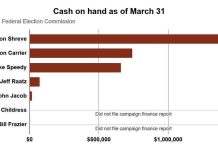The Columbus City Council has approved a $57.8 million budget for 2018.
Next year’s budget is about $1 million less than this year’s $58.9 million budget, a decrease of nearly 2 percent.
The 2018 budget, given final passage Tuesday, also includes nearly $10 million in capital spending that includes:
Fourteen new vehicles for the police department that are being replaced as part of an annual rotation plan, $635,000.
Replacing about 60 body-worn cameras for police officers and the necessary storage for the cameras, $92,000.
A request from the city’s information technology department for $451,000 to update the city’s network and firewall.
$205,000 for a street sweeper in the city’s Department of Public Works department.
The budget calls for a 2 percent raise for all city employees, which will cost $360,000.
Next year’s budget also includes six new city positions:
A compliance officer in the aviation department, to be paid out of its aviation fund.
A payroll clerk in the clerk-treasurer’s office, to be paid out of the city’s general fund.
An engineering technician in the engineering department, also to be paid out of the city’s general fund.
A position in the city’s planning department, to paid using general fund and federal monies.
One position in the police department and another in the fire department, to be paid out of the city’s general fund.
The budget allocation will allow Fire Chief Mike Compton and Police Chief Jon Rohde to fill open positions created by a retirement using funds allocated to the empty positions, city finance director Jamie Brinegar said.
The city estimated each empty position in the police and fire departments would cost roughly $75,000, which includes base salary, insurance and some money for overtime, he said.
“Once the retirement is fully paid out, that position would then become an empty position and available for use should another police officer or firefighter retire,” Brinegar said.
The position being added in the aviation department is not funded through public tax dollars, while the planning department position will be reimbursed 50 percent through federal dollars, Brinegar added.
City Councilman Frank Jerome asked Brinegar during Tuesday’s council meeting how the city’s budget will be impacted by the county’s local income tax going up from 1.25 percent to 1.75 percent starting in January.
Brinegar said that remains unclear at the moment, adding that he didn’t know how much additional revenue the city could anticipate receiving.
“Until we do, we’re not sure what the effect will be,” Brinegar said.
Brinegar also said he wasn’t sure where the increase in revenue would be applied in the city’s budget, whether it would be deposited in the general fund or used in other areas.
The city’s proposed tax rate is at 1.39 per $100 of assessed valuation, but the certified rate will be provided by the Indiana Department of Local Government Finance early next year, Brinegar said.
Mayor Jim Lienhoop had said he expects the tax rate will be about the same as this year.
The council’s vote to approve the budget passed 6-1, with Frank Miller was the sole councilman to vote against passage. Miller said he voted against the 2018 budget because the city had voted in June to raise its cumulative capital development tax rate.
The increase, from $0.0316 to the state maximum of $0.05 per $100 assessed value, is expected to bring in $815,414 annually, city officials said. The money will be used to pay for capital expenses for the police and fire department over the next five years, they said.
Miller said that if the city had not raised its cumulative capital development tax rate, he might have voted in favor of passing the 2018 budget.
“We could’ve lived without the cumulative tax being raised,” he said.
No members of the public spoke on the city budget during the meeting.




